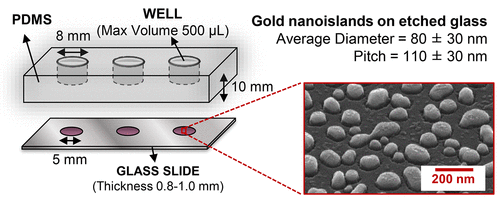当前位置:
X-MOL 学术
›
ACS Appl. Nano Mater.
›
论文详情
Our official English website, www.x-mol.net, welcomes your
feedback! (Note: you will need to create a separate account there.)
Metal-Enhanced Fluorescence Immunosensor Based on Plasmonic Arrays of Gold Nanoislands on an Etched Glass Substrate
ACS Applied Nano Materials ( IF 5.3 ) Pub Date : 2020-09-16 , DOI: 10.1021/acsanm.0c02388 Bruno Miranda 1 , Kang-Yu Chu 2 , Pier Luca Maffettone 3 , Amy Q. Shen 2 , Riccardo Funari 2
ACS Applied Nano Materials ( IF 5.3 ) Pub Date : 2020-09-16 , DOI: 10.1021/acsanm.0c02388 Bruno Miranda 1 , Kang-Yu Chu 2 , Pier Luca Maffettone 3 , Amy Q. Shen 2 , Riccardo Funari 2
Affiliation

|
The recent advances in nanofabrication processes offer encouraging opportunities for designing highly sensitive detection tools. One example is metal-enhanced fluorescence (MEF)-based biosensors: by effectively coupling the metal nanostructures with the fluorescent dye used for the detection of the target molecule, MEF-based sensors exhibit higher sensitivity and lower limit of detection in comparison to traditional optical biosensors. Ordered arrays of nanostructures with coupled fluorophores can potentially achieve thousand-fold enhancement in fluorescence intensity. However, nanofabrication techniques required for ordered nanostructures tend to be time consuming and costly. On the other hand, with moderate enhancement, randomly assembled nanoplasmonic arrays on large-scale substrates can be realized by easy, cost-effective, and reliable methodologies in a relatively short time, thus being more suitable for mass production. In this work, we develop a MEF-based immunosensor involving randomly assembled plasmonic arrays of gold nanoparticles fabricated by a simple and versatile three-step process to modulate the size, the interparticle distance, and the optical properties of the gold nanostructures to achieve the optimal fluorescence enhancement. Specifically, we have tested three different fluorescent dyes (Alexa Fluor 488, Alexa Fluor 546, and PE-Cy7) coupled with optimized gold nanostructures and achieved up to ≈170-fold enhancement in the fluorescence emission, significantly better than those achieved by metal nanostructures in solutions and by randomly assembled nanoplasmonic arrays. Our MEF immunosensor is then employed for detecting immunoglobulins in a model antigen–antibody system, achieving a limit of detection of 4.3 ng/mL. This value is lower than that of similar immunoglobulin detection assays and offers promising opportunities for a wide range of biosensing applications.
中文翻译:

基于蚀刻玻璃基板上金纳米岛的等离子阵列的金属增强型荧光免疫传感器。
纳米制造工艺的最新进展为设计高度灵敏的检测工具提供了令人鼓舞的机会。一个示例是基于金属增强荧光(MEF)的生物传感器:与传统的光学传感器相比,通过将金属纳米结构与用于检测目标分子的荧光染料有效偶联,基于MEF的传感器显示出更高的灵敏度和更低的检测限生物传感器。具有耦合的荧光团的纳米结构的有序阵列可以潜在地实现荧光强度的千倍增强。但是,有序纳米结构所需的纳米制造技术往往既耗时又昂贵。另一方面,通过适度增强,可以通过简单,经济高效的方式在大型基板上随机组装纳米等离子体阵列,在较短的时间内提供可靠的方法,因此更适合批量生产。在这项工作中,我们开发了一种基于MEF的免疫传感器,涉及通过简单而通用的三步过程制造的,随机组装的金纳米粒子的等离激元阵列,以调节金纳米结构的尺寸,粒子间距离和光学特性,以实现最佳效果。荧光增强。具体而言,我们测试了三种不同的荧光染料(Alexa Fluor 488,Alexa Fluor 546和PE-Cy7),它们与优化的金纳米结构相结合,并实现了高达≈170倍的荧光发射增强,明显优于金属纳米结构在溶液中,并通过随机组装的纳米等离子体阵列。然后,我们的MEF免疫传感器被用于检测模型抗原-抗体系统中的免疫球蛋白,检测限达到4.3 ng / mL。该值低于类似的免疫球蛋白检测分析的值,并为广泛的生物传感应用提供了有希望的机会。
更新日期:2020-10-25
中文翻译:

基于蚀刻玻璃基板上金纳米岛的等离子阵列的金属增强型荧光免疫传感器。
纳米制造工艺的最新进展为设计高度灵敏的检测工具提供了令人鼓舞的机会。一个示例是基于金属增强荧光(MEF)的生物传感器:与传统的光学传感器相比,通过将金属纳米结构与用于检测目标分子的荧光染料有效偶联,基于MEF的传感器显示出更高的灵敏度和更低的检测限生物传感器。具有耦合的荧光团的纳米结构的有序阵列可以潜在地实现荧光强度的千倍增强。但是,有序纳米结构所需的纳米制造技术往往既耗时又昂贵。另一方面,通过适度增强,可以通过简单,经济高效的方式在大型基板上随机组装纳米等离子体阵列,在较短的时间内提供可靠的方法,因此更适合批量生产。在这项工作中,我们开发了一种基于MEF的免疫传感器,涉及通过简单而通用的三步过程制造的,随机组装的金纳米粒子的等离激元阵列,以调节金纳米结构的尺寸,粒子间距离和光学特性,以实现最佳效果。荧光增强。具体而言,我们测试了三种不同的荧光染料(Alexa Fluor 488,Alexa Fluor 546和PE-Cy7),它们与优化的金纳米结构相结合,并实现了高达≈170倍的荧光发射增强,明显优于金属纳米结构在溶液中,并通过随机组装的纳米等离子体阵列。然后,我们的MEF免疫传感器被用于检测模型抗原-抗体系统中的免疫球蛋白,检测限达到4.3 ng / mL。该值低于类似的免疫球蛋白检测分析的值,并为广泛的生物传感应用提供了有希望的机会。











































 京公网安备 11010802027423号
京公网安备 11010802027423号